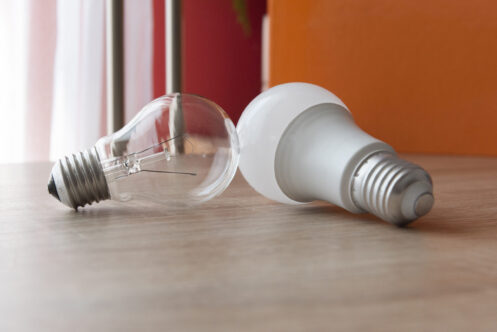Ensuring your Raleigh, NC home has adequate lighting is important for a variety of reasons. The type and size of light bulbs you use in all your home’s light fixtures makes a bigger difference than you may realize. In this article, we’ll discuss all you need to know about your different lighting options. This includes how to choose the right type and size of light bulb for all your indoor and outdoor light fixtures.
Why Incandescent Light Bulbs Are Now Banned
If you’ve shopped for light bulbs in the past year, you may have noticed that there are no longer traditional incandescent bulbs on the shelves. In August 2023, the U.S. finally took the step to ban the sale of most incandescent light bulbs. The ban doesn’t prohibit anyone from using any bulbs they have already purchased beforehand. However, it does mean everyone will need to switch to either compact fluorescent (CFL) or LED lights in their light fixtures. The reason for the ban is simply that incandescent lights are extremely inefficient and use many times more energy than other types of lights.
LED vs. CFL Light Bulbs
When comparing LED and compact fluorescent (CFL) light bulbs, LEDs are the hands-down winner for a few different reasons. The primary reason is that LED lights are more efficient and use less electricity to produce the same amount of light. CFLs are around 2% to 35% more efficient than incandescent light bulbs. LEDs are around 75% more efficient. The improved efficiency is mostly because LEDs convert most of the electricity they produce into light and only a small percentage into heat. CFLs and especially incandescent light bulbs are less efficient since a higher proportion of the watts of electricity they use gets converted into heat compared to the lumens of light they produce.
The higher heat production of CFLs is another reason why LEDs are superior. The heat production isn’t an issue in the winter, but having CFL lights around your home will contribute to it getting hotter more quickly in the summer. This increased heat gain in turn leads to a greater workload for your air conditioning system, which results in it using more energy.
Another major advantage of using LED light bulbs is that they have a longer life expectancy. The average lifespan of a CFL bulb is between 8,000 and 15,000 hours. That means you can typically expect a CFL bulb to last for around three to five years if it normally stays on for eight hours a day. Most LED light bulbs last for at least 25,000 hours and some higher-quality bulbs can potentially last even twice as long. That means you may not need to worry about having to replace a new bulb for 10 or even 20 years.
You also have many more color choices when you opt for LED lights. When LED bulbs first came out, many of them produced a harsh, blue light that a lot of people found unpleasant. Nowadays, you have a few different options to choose from depending on how much light you need and what room you’re trying to light. All CFL bulbs produce a strong, white light, which is fine for certain situations. It’s not ideal for others. If you choose LEDs, you can opt for those that produce a softer, yellow light that is much more like what you’re used to from incandescent bulbs.
How to Choose the Right LED Lights for Each Fixture in Your Home
Knowing what size of LED light bulb to use in any of your home’s light fixtures is simple. Most light fixtures have a sticker or label somewhere on them that displays what size of bulb they are rated for. Even for newer fixtures, this rating is usually expressed in terms of wattage. Most of your overhead lighting is typically rated for 60- or 80-watt bulbs, while lamps and other smaller lights are often only 40 watts. When shopping for LEDs, they always list how many watts they consume but also what they are equivalent to in terms of the wattage for incandescent lights. That means if your fixture is rated to handle a 60- or 80-watt bulb, all you need to do is find which size of LED is the equivalent.
The other thing you need to pay attention to when it comes to LED lights is the color spectrum. Bulbs in the blue or bright white spectrum are best used for specific fixtures, such as porch and security lighting. You normally want to avoid bright blue lights inside your house since blue light best mimics sunlight. That means it can interfere with your body’s internal clock and cause difficulties with falling asleep.
Bright white bulbs are also a good choice for a home office, mirror lighting in the bathroom and potentially some of your overhead kitchen lighting. They’re also good for reading lamps since they allow you to see better compared to bulbs that produce a softer white or yellow light. For bedrooms and living rooms, most people prefer the color of soft white or yellow LEDs since it is less harsh on the eyes.
Dimmable vs. Not-Dimmable Light Bulbs
Many homes use dimmer switches to control the lighting in areas like the living room, dining room and bedrooms. If you have any dimmable fixtures in your house, it’s important to note that not all LEDs or CFLs are dimmable. Using a non-dimmable LED bulb in a dimmable fixture will almost always result in the bulb going out much sooner. You will often also encounter issues with your lights sometimes flickering when the fixture is dimmed. Using a non-dimmable CFL in a dimmable fixture is a much bigger issue since there have been situations where it resulted in an electrical fire.
One final thing to note if you have any dimmable fixtures is that older dimmer switches were designed for incandescent bulbs. The issue in this regard is that the amount of wattage they supply when the fixture is dimmed is much higher than what LEDs need to work. The reason that this is an issue is that the higher wattage will usually cause LED bulbs to burn out much faster.
If you have a dimmer switch that was installed more than 15 or so years ago or the LEDs in that fixture keep burning out sooner than they should, it’s usually a sign that you have the old style of dimmer switch. In this situation, upgrading to a new, LED-compatible dimmer switch will allow your light bulbs to last longer and potentially save you some money down the road.
Whether you’re looking to upgrade your home’s indoor or outdoor lighting or need any other home service, you can turn to the team at Thermo Direct for help. We’ve been serving Raleigh and the surrounding areas since 2000. We are one of the area’s leading electrical, HVAC and plumbing contractors. We install, maintain, and repair all heating and cooling equipment. This includes mini-splits. We can service gas lines, provide leak detection, address burst and frozen pipes, and more. No matter what service you need, you can also trust we’ll get the job done right thanks to our 100% customer satisfaction guarantee. Contact us today if you need to schedule an electrical service call or if you have any questions.









